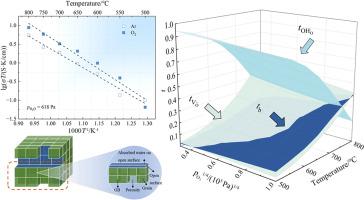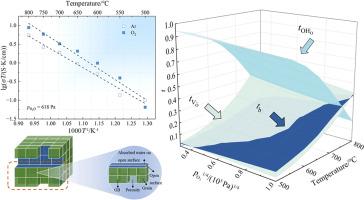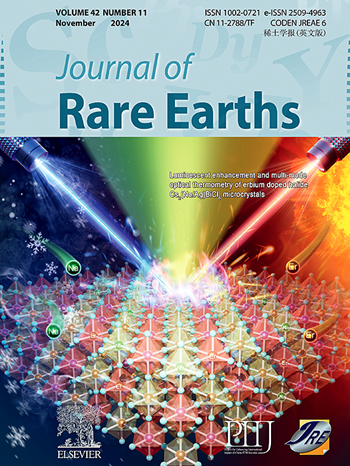非烧结 BaCe0.8Y0.2O3-α 中的质子传输,用于轻松制备电化学设备
IF 7.2
1区 化学
Q1 CHEMISTRY, APPLIED
引用次数: 0
摘要
在相关材料中,BaCe0.8Y0.2O3-α 陶瓷具有卓越的导电性。然而,高温烧结使得用 BaCe0.8Y0.2O3-α 多层膜制备电化学器件变得困难,而且很少有研究对未烧结 BaCe0.8Y0.2O3-α 的导电性和传输特性进行研究。在名义上干燥的条件下,这种材料在含水环境中的不稳定性可以降到最低,从而使非烧结 BaCe0.8Y0.2O3-α 可以作为电化学器件的一个组成部分应用于某些特定的测试环境中。因此,在 500-800 °C 的温度范围内,通过交流阻抗光谱法测量了未烧结 BaCe0.8Y0.2O3-α 在干燥条件下的电导率。未烧结的 BaCe0.8Y0.2O3-α 表现出较高的导电性和水合能力,以及较低的质子活化能。此外,受其晶界的限制,它在高温下显示出高氧空位和低质子传输数。这项研究深入探讨了未烧结 BaCe0.8Y0.2O3-α 的导电性和质子传输,并证明了其作为质子传导电解质的潜力。本文章由计算机程序翻译,如有差异,请以英文原文为准。


Proton transport in unsintered BaCe0.8Y0.2O3–α for easily prepared electrochemical devices
BaCe0.8Y0.2O3–α ceramics exhibit superior conductivity among related materials. However, the high-temperature sintering makes it difficult to prepare electrochemical devices with a BaCe0.8Y0.2O3–α multilayer film, and very few studies have examined the conductivity and transport properties of unsintered BaCe0.8Y0.2O3–α. In nominally dry conditions, the instability of this material in a water-containing atmosphere can be minimized, allowing the unsintered BaCe0.8Y0.2O3–α to be applied in some particular test environment as a component of electrochemical devices. Hence, the conductivity of unsintered BaCe0.8Y0.2O3–α in dry conditions was measured via AC impedance spectroscopy in the temperature range of 500–800 °C. The unsintered BaCe0.8Y0.2O3–α exhibits high conductivity and hydration ability, as well as low proton activation energy. In addition, it shows high oxygen vacancy and low proton transport numbers at high temperature, limited by its grain boundaries. This work provides insights into the conductivity and proton transport of unsintered BaCe0.8Y0.2O3–α and demonstrates its potential as a proton-conducting electrolyte.
求助全文
通过发布文献求助,成功后即可免费获取论文全文。
去求助
来源期刊

Journal of Rare Earths
化学-应用化学
CiteScore
8.70
自引率
14.30%
发文量
374
审稿时长
1.7 months
期刊介绍:
The Journal of Rare Earths reports studies on the 17 rare earth elements. It is a unique English-language learned journal that publishes works on various aspects of basic theory and applied science in the field of rare earths (RE). The journal accepts original high-quality original research papers and review articles with inventive content, and complete experimental data. It represents high academic standards and new progress in the RE field. Due to the advantage of abundant RE resources of China, the research on RE develops very actively, and papers on the latest progress in this field emerge every year. It is not only an important resource in which technicians publish and obtain their latest research results on RE, but also an important way of reflecting the updated progress in RE research field.
The Journal of Rare Earths covers all research and application of RE rare earths including spectroscopy, luminescence and phosphors, rare earth catalysis, magnetism and magnetic materials, advanced rare earth materials, RE chemistry & hydrometallurgy, RE metallography & pyrometallurgy, RE new materials, RE solid state physics & solid state chemistry, rare earth applications, RE analysis & test, RE geology & ore dressing, etc.
 求助内容:
求助内容: 应助结果提醒方式:
应助结果提醒方式:


